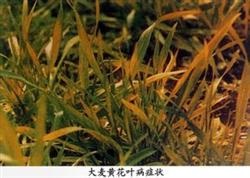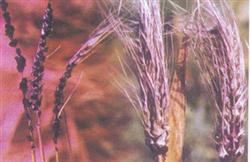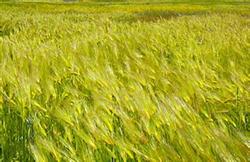Occurrence and control of barley yellow mosaic disease

Barley yellow mosaic disease mainly occurred in Hubei, Zhejiang, Jiangsu, Shanghai and Anhui provinces and cities in the lower reaches of the Yangtze River, especially in Jiangsu, Zhejiang and Shanghai. The diseased plant died ahead of time, resulting in the decrease of ear setting rate, seed setting rate, 1000-grain weight, flour yield and quality of barley. Barley yellow mosaic disease occurred, plant dwarfing, plant type loose, tiller decreased, root system dysplasia, brown root increased. At the early stage of tillering, short strip chlorotic spots parallel to the leaf veins appeared on the unspreading heart leaves, and the chlorotic spots gradually developed and connected, resulting in mosaic-like leaves. After heading, the symptoms of the upper leaves of mildly diseased plants disappeared, some of the seriously diseased plants could not heading, some of them could heading, but the panicle was small, there were many empty chaff grains, and there were still chlorotic mosaic symptoms on flag leaves, leaf sheaths and even glumes. When the conditions are suitable, barley can show obvious symptoms 1-2 months after sowing. The pathogen of the disease is barley yellow mosaic virus, which can be transmitted by friction between cereal polymyxomycetes and sap in soil. The occurrence of barley yellow mosaic disease varies greatly among different varieties. generally, six-rowed barley is more resistant and two-rowed barley is highly susceptible to the disease. The large-scale planting of susceptible varieties and the accumulation of viral vectors and sources year by year are the important reasons for the continuous expansion of the occurrence area and the increasing degree of occurrence of the disease. As high soil moisture and 15 ℃ temperature are needed for zoospore infection and transmission by cereal polymyxomycetes, the suitable temperature and heavy rain in autumn and winter is beneficial to the occurrence of the disease. On the contrary, the sowing season is dry and less rainy, the temperature is low, and the disease is light or late. Autumn sowing in Jiangsu, Zhejiang and Shanghai is mostly from October to November, when the soil temperature coincides with the suitable soil temperature for zoospore invasion and transmission of cereal polymyxus. The earlier the sowing is, the earlier and more serious the disease is, and the appropriate late sowing can avoid the peak period of infection and transmission of cereal polymyxus, so postponing sowing can reduce the occurrence of the disease. When the disease of barley is serious, rotation should be carried out and flood-drought rotation should be advocated. Strict control of the spread of diseased soil, deep turning of diseased soil or pressing disease-free soil in seriously diseased fields can control the occurrence of diseases to a certain extent. The application of fertilizer to the diseased field can delay the development of the disease and promote the recovery of physiological function of diseased plants.
- Prev

How is barley kernel smut transmitted? What's the cure?
How is barley kernel smut transmitted? What are the ways to prevent it? (1)Occurrence rule: Barley hard smut fungus transmission route has two cases: one case is when threshing mixed with black powder (chlamydospore), chlamydospore adhesion on the surface of the seed, barley sowing, chlamydospore germination into hyphae, invasion of wheat seedlings young group...
- Next

Introduction of barley in different places
1. Seed preparation and sowing rate barley seeds should choose the variety Smur4 with high quality and high yield, and S500 can be used as a matching variety. The sowing amount of corn stubble field is 10m / mu, and that of flue-cured tobacco and corn field is 8m / mu, 8kg / mu. Second, timely sowing barley is not as strict as wheat in sowing time.
Related
- The first cup of black tea in spring, the flavor and history of tea gardens in Kenya, Africa
- The computer can not only choose potatoes, but also grow tea rice. AI will grow winter oolong tea champion.
- It is not only the inflated tea bitten by insects, but also engraved with the four seasons tea in Beipu.
- The Oriental Beauty Tea Festival in Zhuxian County takes the stage at the weekend to experience the plus-size feast of oil tea.
- & quot; Oriental Beauty Tea & Exploration of Emei in Hsinchu, the hometown of quot;
- The new variety of strawberry "Tainong 1" dessert is the first choice with mellow aroma. Crimson gorgeous
- History of Tea in Taiwan: from Wild Inner Mountain to Export Tea Garden
- Two types of Taiwan Oriental Beauty Black Tea won the British three-Star Award for Childhood Tea Xiang Zhang Jiaqi changed from pilot to champion tea maker.
- Banana species and varieties: the planting history of Taiwan Xianren banana and dwarf banana is long, is banana disease resistant?
- Coffee planting Technology: Qianjie Coffee from Seedling to harvesting

